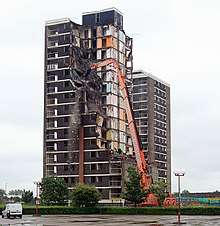Croxteth
Croxteth is a suburb of Liverpool, Merseyside, England, and a Liverpool City Council Ward. Although housing in the area is predominantly modern, the suburb has some notable history. It is known locally as "Crocky". At the United Kingdom 2011 Census it had a population of 14,561.[1]
| Croxteth | |
|---|---|
Church of the Good Shepherd, Croxteth | |
 Croxteth Location within Merseyside | |
| Population | 16,543 |
| OS grid reference | SJ405961 |
| Metropolitan borough | |
| Metropolitan county | |
| Region | |
| Country | England |
| Sovereign state | United Kingdom |
| Post town | LIVERPOOL |
| Postcode district | L11 |
| Dialling code | 0151 |
| Police | Merseyside |
| Fire | Merseyside |
| Ambulance | North West |
| UK Parliament | |
History
The name is believed to derive from a contraction of Crocker's Staithe, or the landing place of Crocker, which is a likely reference to a Viking landing via the River Alt, which passes through Croxteth and at the time of the Viking invasion of Britain was navigable through the area. The similar root is also possible for Toxteth.
Prehistoric tools were found on a site in Croxteth in 1992, though there were no signs of any permanent settlement. Since then the land has been developed.[2]
The suburb is adjacent to Croxteth Hall, the former home of the Earls of Sefton, and close to West Derby, another suburb that predates Liverpool, being recorded in the Domesday Book. The "Dog and Gun" public house (demolished in 2005) was a historic hostelry, likely associated with the hunt from Croxteth Hall.
The first tranche of housing in Croxteth was built to rehouse families from the Scotland Road area of the city that was subject to mass demolition during the construction of the second Mersey Tunnel. Within the past twenty years very large areas of Croxteth Park and a City Council playing field have been sold for housing development to create a huge housing estate, noted for its lack of local amenities.
From the A580 road (the Liverpool-East Lancashire Road, abbreviated to and known commonly as East Lancs Road) passing Malpas Road to St. Swithens including the much talked about haunting of Gillmoss School. Croxteth was one of the first "suburbs of Liverpool". Croxteth Park, a development area, came many years later.

The first houses in the Croxteth estate were in fact built in the immediate postwar period to house skilled workers from Slough and Rugby who had been brought in to the English Electric and Napier factories on the East Lancs Road), and families from the dockland inner-city areas who had lost their homes through bombing and slum demolition. The second tunnel came much later. The first families arrived in 1951 to live in an estate that was without roads, pavements, shops, pubs or buses. However, in the wake of World War II during the late 1940s and early 1950s, massive residential extensions at Croxteth, alongside similar and indistinguishable development of neighbouring Norris Green, resulted in what together, are now regarded as the largest municipal housing estate in Europe.
Education
The area is serviced by two secondary schools (11-18); St. John Bosco (Catholic Girls) and De La Salle (Catholic Boys). In 2010, a third school, Croxteth Community Comprehensive (Mixed), closed due to poor academic standards and falling pupils numbers, despite local protests and the school achieving higher academic standards in OFSTED reports and on average higher student grades than De La Salle. In June 2008 it was revealed a new £20m "super-school" would be built on the site of De La Salle.[3] However, this proposal has since been scrapped.
Notable residents
Former England footballer Wayne Rooney and his wife Coleen (nee McLoughlin) grew up and met in the area. Coleen was a pupil at St John Bosco School[4] and Wayne attended De La Salle School.[5]
One-time England footballer Francis Jeffers also attended De La Salle School.[6]
Robert Pope, a notable distance runner who became the first person to complete the 15,600-mile Forrest Gump run, was born and raised in the area.[7]
References
- "2001 Census: Croxteth". Office for National Statistics. 2001. Retrieved 21 July 2010.
- "Prehistoric Merseyside: Croxteth Park". Liverpool Museums. Archived from the original on 16 April 2007. Retrieved 7 April 2007.
- "£20m dream for a school of the future". Liverpool Echo. 10 June 2008. Retrieved 19 June 2008.
- Lusher, Adam (26 February 2006). "The new Colleen? Not me, says Andy's girl". The Telegraph. Retrieved 18 October 2010.
- Walker, Michael (5 June 2010). "The real Wayne Rooney: How a working class kid from a bleak city landscape scarred by drugs, guns and murder emerged as a phenomenon". Mail Online. Retrieved 18 October 2010.
- Stammers, Steve (21 March 2010). "Jeffers: My mate Wayne Rooney, aged 171⁄2". London Evening Standard. Retrieved 18 October 2010.
- Fitzsimmons, Francesca (17 September 2016). "Watch Croxteth vet's story as he starts Forrest Gump run across America". liverpoolecho. Retrieved 18 October 2019.
External links
| Wikimedia Commons has media related to Croxteth. |